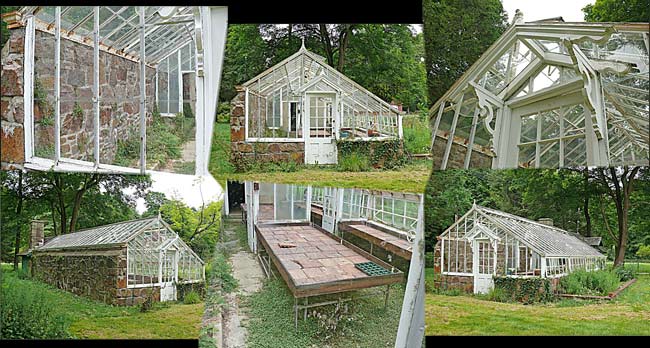Carnegie donated libraries, how about Greenhouses today?
Submitted by Jeff Buster on Mon, 01/04/2010 - 12:55.

Andrew Carnegie provided over 2,500 libraries across the world between 1883 and 1929. What a great idea and gift. The Brooklyn Branch of the Cleveland Public Library is one of Carnegie's libraries.
Community green houses would provide an important civic function - just as libraries provide a healthy physical nexus for people to access information and to meet their neighbors and discuss books and issues. The green house in the mash up above (located at the Land Mark School in Beverly, Massachusetts) is probably a century old. Though in pretty good shape, it was, sadly, not getting much use.
The design is smart - the north wall is stone (should have been insulated outside) which acts as a solar heat sink all day and then radiates the heat back into the greenhouse at night. The tables had terra cotta tile floors supported on a metal frame. Check out the handsome woodwork over the entry door - providing a glass roof over the entry stoop.
How would you like to have one of these in your back yard? or in your neighborhood for your shared use with your neighbors?
( categories: )
|
green house
I sure would
a greenhouse here too
I would love to have one, or access to one. A community greenhouse would be the way to go in a more idea world. I am curious JBuster, about your comment that the north side should have been insulated: north side of the greenhouse, or north side of the stone wall?
North/outside of stone wall
What about a program to reuse greenhouses?
I grew up on the westside where there used to be so many nurseries with greenhouses. In the last twenty years or so I have watch the landscape and the economy of the westside change so much, many greenhouses have been torn down to make way for development or they stand neglected and unused because local growers can't compete with the price of flats of flowers and vegetables sold by Home Depot. We need a program to locate greenhouses and match them with groups and individuals who could use them. I know that there is an unused greenhouse at St. Philomena's in East Cleveland and I would love to have a place to start seedlings for my garden. Setting up a greenhouse in my own yard or a growing area in my basement just doesn't seem practical right noiw. I am sure there must be people in my neighborhood who would like to share the space.